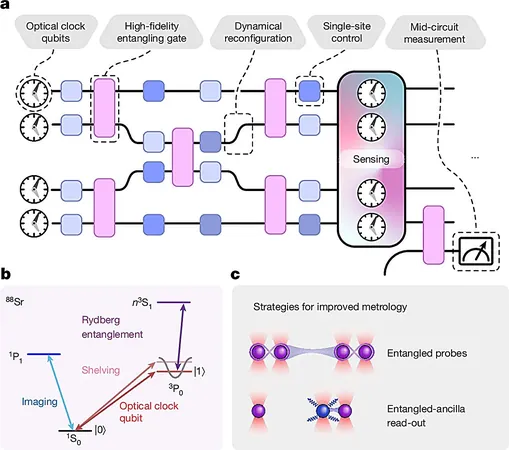
Unlocking the Universe: How Merging Atomic Clocks with Quantum Computers Could Revolutionize Measurements
2024-10-09
Author: Nur
Introduction
In the realm of physics, precision is paramount. Scientists aim to measure quantities at scales that are almost unimaginable, delving into distances smaller than even the tiniest subatomic particles. But there's more: they're striving for time measurements that are accurate to within a mere second every tens of billions of years. This pursuit of extraordinary precision has birthed a dynamic field known as quantum metrology.
A Groundbreaking Study
A groundbreaking study published in the esteemed journal *Nature* has revealed how a team from Caltech, headed by Professor Manuel Endres, has propelled us into a new era of precision timing. This innovative research fuses cutting-edge atomic clocks with advanced quantum computers, promising unprecedented accuracy in timekeeping.
Key Contributors and Ambitions
"Our ambition is to reach the ultimate precision that nature permits," comments Endres as he highlights their recent advancements. The key contributors to this ambitious project include former Caltech postdoctoral scholar Ran Finkelstein, currently at Tel Aviv University, alongside graduate students Richard Bing-Shiun Tsai and Xiangkai Sun.
Implications for Fundamental Natural Laws
This new device promises to revolutionize our understanding of fundamental natural laws, including the complexities of Albert Einstein's general theory of relativity. It also holds the potential to unlock some of the most enigmatic questions in modern physics, such as the infamous dark matter puzzle. High-precision measurements like those produced by these advanced clocks can also facilitate the detection of gravitational waves—those subtle ripples in the fabric of space-time. Notably, the Laser Interferometer Gravitational-wave Observatory (LIGO), co-managed by Caltech and MIT, reached new milestones in quantum metrology thanks to this ongoing research effort.
Tweezer Clocks and Quantum Integration
Endres’s team previously explored “tweezer clocks,” elaborate systems that utilize arrays of neutral strontium atoms, each manipulated by lasers acting as optical tweezers. On their own, these tweezer clocks achieve remarkable timekeeping precision. However, their latest study showcases how integrating quantum computations within these clocks can push the limits of accuracy even further.
The Challenge of Entanglement
"Atomic clocks harness quantum mechanics for time measurement, while quantum computers apply quantum principles to conduct calculations," says Endres. "Our work merges these two advanced domains." The primary challenge the researchers faced was achieving entanglement among the atoms in their tweezer clock array. Entanglement, a cornerstone of quantum mechanics, allows particles to become interconnected, impacting one another even when separated by vast distances. "Greater precision is attainable through entangled states," explains Endres, underscoring the necessity for a complex entanglement specific to their work.
Future Directions
The findings of this study elucidate not only the feasibility of such entanglement but also confirm that quantum computers can be synergistically integrated with quantum sensors, such as atomic clocks. Moving forward, the Caltech team aims to further reduce errors in their system, driving their clocks closer to the theoretical boundaries of precision.
Conclusion
As we stand on the cusp of a new frontier in measurement technology, the integration of atomic clocks and quantum computing appears set to unlock secrets about the very fabric of our universe, paving the way for revolutionary advancements across physics, astronomy, and even technology itself. Prepare to witness the future as it unfolds—what mysteries of the cosmos will we uncover next? Stay tuned!



 Brasil (PT)
Brasil (PT)
 Canada (EN)
Canada (EN)
 Chile (ES)
Chile (ES)
 España (ES)
España (ES)
 France (FR)
France (FR)
 Hong Kong (EN)
Hong Kong (EN)
 Italia (IT)
Italia (IT)
 日本 (JA)
日本 (JA)
 Magyarország (HU)
Magyarország (HU)
 Norge (NO)
Norge (NO)
 Polska (PL)
Polska (PL)
 Schweiz (DE)
Schweiz (DE)
 Singapore (EN)
Singapore (EN)
 Sverige (SV)
Sverige (SV)
 Suomi (FI)
Suomi (FI)
 Türkiye (TR)
Türkiye (TR)